溫馨提示×
您好,登錄后才能下訂單哦!
點擊 登錄注冊 即表示同意《億速云用戶服務條款》
您好,登錄后才能下訂單哦!
這篇文章主要介紹了python數學建模之Numpy和Pandas怎么應用的相關知識,內容詳細易懂,操作簡單快捷,具有一定借鑒價值,相信大家閱讀完這篇python數學建模之Numpy和Pandas怎么應用文章都會有所收獲,下面我們一起來看看吧。
# Numpy的基本使用 ''' Numpy提供了兩種基本的對象:ndarray存儲單一數據類型的多維數組; ufunc是能夠對數組進行處理的函數 1-導入函數 import numpy as np 2-數組創建 2-1 array 可將列表或元組轉化為ndarray數組 2-2 arange 在給定區間內創建等差數組,格式: arange(start=None, stop=None, step=None,dtype=None) 【step表示步長間隔】 2-3 linspace 在給定區間內創建間隔相等的數組,格式: linspace(start, stop, num=50, endpoint=True) 【間隔相等的num個數據,其num默認值是50】 2-4 logspace 在給定區間內生成等比數組,格式: logspace(start, stop, num=50, endpoint=True, base=10.0) 【默認生成區間[10start(次方), 10stop()次方]上的num個數據的等比數組】 以及 ones、zeros、empty和ones_like等系列函數的運用: '''
# numpy.array
# array()函數,括號內可以是列表、元組、數組、迭代對象、生成器
import numpy as np
print(np.array([6, 6, 6])) # 列表
print(np.array((8, 8, 8))) # 元組
print(np.array(np.array([9, 9, 9]))) # 數組
print(np.array(range(10))) # 迭代對象 / 整型
print(np.array([i**2 for i in range(10)])) # 生成器
# 創建10以內的奇數的數組:
print(np.array([i for i in range(1, 10, 2)]))
print(np.array([i for i in range(10) if i % 2 != 0]))
# 創建10以內的偶數的數組:
print(np.array([i for i in range(0, 10, 2)]))
print(np.array([i for i in range(10) if i % 2 == 0]))
# 列表中元素類型不相同
print(np.array([5, 2, '0'])) # ['5' '2' '0']
# 浮點型
print(np.array([3, 4, 5.2]))
# 二維數組:【嵌套序列(列表、元組均可)】
print(np.array([[6, 7, 8], ('lxw', 'cw', 'wl')]))
print(np.array([[6, 7, 8], ('lxw', 'cw', 'wl')]).ndim) # ndim(維度): 2
# 嵌套數量不一致:【強制轉化為一維,推薦不用】
print(np.array([[6, 7, 8], ('lxw', 'cw', 'wl', 'npy')], dtype=object))
print(np.array([[6, 7, 8], ('lxw', 'cw', 'wl', 'npy')], dtype=object).ndim) # ndim(維度):1
print(np.array([[6, 7, 8], ('lxw', 'cw', 'wl', 'npy')], dtype=object).shape) # 運行結果:(2,)
print(np.array([[6, 7, 8], [9, 9, 6, 9]], dtype=object))
print(np.array([[6, 7, 8], [9, 9, 6, 9]], dtype=object).ndim) # ndim(維度):1
print(np.array([[6, 7, 8], [9, 9, 6, 9]], dtype=object).shape) # 運行結果:(2,) -> 代表兩行一列# numpy.empty ''' numpy.empty 方法用來創建一個指定形狀(shape)、數據類型(dtype)且未初始化的數組 numpy.empty(shape, dtype = float, order = 'C') 參數說明: 參數 描述 shape 數組形狀 dtype 數據類型,可選 order 有"C"和"F"兩個選項,分別代表,行優先和列優先,在計算機內存中的存儲元素的順序 ''' import numpy as np lxw = np.empty([3, 4], dtype=int) print(lxw) # 注意:數組元素為隨機值,因為它們未初始化
# numpy.zeros
'''
創建指定大小的數組,數組元素以 0 來填充:
numpy.zeros(shape, dtype = float, order = 'C')
參數說明:
order : 'C' 用于 C 的行數組,或者 'F' 用于 FORTRAN 的列數組
'''
import numpy as np
lxw = np.zeros(6) # 默認為浮點數
print(lxw)
lxw2 = np.zeros((6, ), dtype=int) # 設置類型為整數
print(lxw2)
# 自定義類型
lxw3 = np.zeros((2, 2), dtype=[('lxw', 'i2'), ('lxw2', 'i4')])
print(lxw3)# numpy.ones '''創建指定形狀的數組,數組元素以 1 來填充: numpy.ones(shape, dtype = None, order = 'C') ''' import numpy as np lxw4 = np.ones(8) # 默認浮點數 print(lxw4) lxw5 = np.ones([2, 2], dtype=int) print(lxw5)
# numpy.asarray ''' numpy.asarray 類似 numpy.array,但 numpy.asarray 參數只有三個,比 numpy.array 少兩個。 numpy.asarray(a, dtype = None, order = None) 參數說明: 參數 描述 a 任意形式的輸入參數,可以是,列表, 列表的元組, 元組, 元組的元組, 元組的列表,多維數組 ''' # 將列表轉換為 ndarray: import numpy as np x = [5, 2, 0] lxw6 = np.asarray(x) print(lxw6) # 將元組轉換為 ndarray import numpy as np x2 = (1, 3, 1, 4) lxw7 = np.asarray(x2) print(lxw7) # 設置了 dtype 參數 import numpy as np x4 = [6, 6, 9] lxw9 = np.asarray(x4, dtype=float) print(lxw9)
# numpy.frombuffer ''' numpy.frombuffer 用于實現動態數組;接受 buffer 輸入參數,以流的形式讀入轉化成 ndarray 對象。 格式如下: numpy.frombuffer(buffer, dtype = float, count = -1, offset = 0) 注:buffer 是字符串的時候,Python3 默認 str 是 Unicode 類型,所以要轉成 bytestring 在原 str 前加上 b。 參數說明: 參數 描述 buffer 可以是任意對象,會以流的形式讀入。 dtype 返回數組的數據類型,可選 count 讀取的數據數量,默認為-1,讀取所有數據。 offset 讀取的起始位置,默認為0 ''' import numpy as np s = b'lxw_pro' lxw10 = np.frombuffer(s, dtype='S1') print(lxw10)
# numpy.fromiter ''' numpy.fromiter 方法從可迭代對象中建立 ndarray 對象,返回一維數組。 numpy.fromiter(iterable, dtype, count=-1) ''' import numpy as np lst = range(6) it = iter(lst) lxw11 = np.fromiter(it, dtype=float) print(lxw11)
# numpy.arange ''' numpy 包中的使用 arange 函數創建數值范圍并返回 ndarray 對象,函數格式如下: numpy.arange(start, stop, step, dtype) 根據 start 與 stop 指定的范圍以及 step 設定的步長,生成一個 ndarray。 參數說明: 參數 描述 start 起始值,默認為0 stop 終止值(不包含) step 步長,默認為1 dtype 返回ndarray的數據類型,如果沒有提供,則會使用輸入數據的類型 ''' # 生成0和5的數組 import numpy as np a = np.arange(6) print(a) # 設置返回類型位 float import numpy as np a2 = np.arange(6, dtype=float) print(a2) # 設置了起始值、終止值及步長 import numpy as np a3 = np.arange(20, 52, 5) print(a3)
# numpy.linspace ''' numpy.linspace 函數用于創建一個一維數組,數組是一個等差數列構成的,格式如下: np.linspace(start, stop, num=50, endpoint=True, retstep=False, dtype=None) 參數說明: 參數 描述 start 序列的起始值 stop 序列的終止值,如果endpoint為true,該值包含于數列中 num 要生成的等步長的樣本數量,默認為50 endpoint 該值為 true 時,數列中包含stop值,反之不包含,默認是True。 retstep 如果為 True 時,生成的數組中會顯示間距,反之不顯示。 dtype ndarray 的數據類型 ''' # 類似等差數列 import numpy as np a4 = np.linspace(1, 10, 5) print(a4) # 設置元素全部是1的等差數列 import numpy as np a5 = np.linspace(1, 1, 10) print(a5) # 將 endpoint 設為 false,不包含終止值 import numpy as np a6 = np.linspace(8, 22, 4, endpoint=False) print(a6) # 注:將 endpoint 設為 true,則會包含 22 a6 = np.linspace(8, 22, 4, endpoint=True) print(a6) # 設置間距 import numpy as np a7 = np.linspace(5, 10, 5).reshape([5, 1]) print(a7)
# numpy.logspace ''' numpy.logspace 函數用于創建一個于等比數列。格式如下: np.logspace(start, stop, num=50, endpoint=True, base=10.0, dtype=None) base 參數意思是取對數的時候 log 的下標。 參數 描述 start 序列的起始值為:base ** start stop 序列的終止值為:base ** stop。如果endpoint為true,該值包含于數列中 num 要生成的等步長的樣本數量,默認為50 endpoint 該值為 true 時,數列中中包含stop值,反之不包含,默認是True。 base 對數 log 的底數。 dtype ndarray 的數據類型 ''' import numpy as np a8 = np.logspace(1, 2, num=10) # 默認底數是 10 print(a8) # 將對數的底數設置為 2 import numpy as np a9 = np.logspace(0, 8, 9, base=2) print(a9)
# 綜合運用 import numpy as np ltw = np.array([3, 3, 4, 4]) # 生成整型數組 ltw2 = ltw.astype(float) # 轉為浮點數 ltw3 = np.array([5, 2, 1], dtype=float) # 浮點數 print(ltw) print(ltw2) print(ltw3) # 比較類型 print(ltw.dtype, ltw2.dtype, ltw3.dtype) aa = np.array([ [2, 5, 8], [9, 6, 2] ]) print(aa) bb = np.arange(2, 9) print(bb) # 運行結果為:[2 3 4 5 6 7 8] cc = np.linspace(2, 5, 4) print(cc) # 運行結果為:[2. 3. 4. 5.] dd = np.logspace(1, 4, 4, base=2) # base控制的是幾次方 print(dd) # 運行結果為:[ 2. 4. 8. 16.]
# 綜合運用【ones、zeros、empty、ones_like】 import numpy as np a = np.ones(6, dtype=int) print(a) # 運行結果為:[1 1 1 1 1 1] b = np.ones((6,), dtype=int) print(b) # 運行結果為:[1 1 1 1 1 1] c = np.ones((3, 1)) print(c) # 輸出3行一列的數組 # 運行結果為: # [[1.] # [1.] # [1.]] d = np.zeros(4) print(d) # 運行結果為:[0. 0. 0. 0.] e = np.empty(3) print(e) # 生成3個元素的空數組行向量 # 運行結果為:[1. 1. 1.] f = np.eye(3) print(f) # 生成3階單位陣 # 運行結果為: # [[1. 0. 0.] # [0. 1. 0.] # [0. 0. 1.]] g = np.eye(3, k=1) print(g) # 生成第k對角線的元素為1,其他元素為0的3階方陣 # 運行結果為: # [[0. 1. 0.] # [0. 0. 1.] # [0. 0. 0.]] h = np.zeros_like(b) print(h) # 生成與a同維數的全0數組 # 運行結果為:[0 0 0 0 0 0]
# NumPy 切片和索引 ''' ndarray對象的內容可以通過索引或切片來訪問和修改,與 Python 中 list 的切片操作一樣。 ndarray 數組可以基于 0 - n 的下標進行索引, 切片對象可以通過內置的 slice 函數,并設置 start, stop 及 step 參數進行,從原數組中切割出一個新數組 ''' import numpy as np # 通過 arange() 函數創建 ndarray 對象 a = np.arange(10) lxw = slice(2, 9, 3) # 索引從2到9,間隔為3 print(a[lxw]) # [2 5 8] # 通過切片操作 a = np.arange(10) lxw2 = a[2:9:3] # 這里的切片操作和Python中list的操作是一樣的 print(lxw2) # [2 5 8] # 比如: import numpy as np lxw3 = np.arange(10) print(lxw3[6]) # 6 print(lxw3[6:]) # [6 7 8 9] print(lxw3[2:7]) # [2 3 4 5 6] # 多維數組同樣適用上述索引提取方法 import numpy as np lxw4 = np.array([ [6, 6, 6], [5, 2, 0], [5, 8, 9] ]) print(lxw4) print(lxw4[1:]) # 切片還可以包括省略號 …,來使選擇元組的長度與數組的維度相同。 # 如果在行位置使用省略號,它將返回包含行中元素的 ndarray import numpy as np lxw5 = np.array([ [1, 2, 9], [2, 5, 4], [3, 4, 8] ]) print(lxw5[1, ...]) # [2 5 4] 第二行元素 print(lxw5[..., 2]) # [9 4 8] 第三列元素 print(lxw5[1:, ...]) # 第二行及剩下元素 print(lxw5[..., 1:]) # 第二列及剩下元素
Numpy中的array數組與Python基礎數據結構列表(list)的區別是:
列表中的元素可以是不同的數據類型array數組只允許存儲相同的數據類型
NumPy 比一般的 Python 序列提供更多的索引方式。
除了之前看到的用整數和切片的索引外,數組可以由
整數數組索引布爾索引花式索引
# 1-整數數組索引 import numpy as np b = np.array([ [6, 2, 9], [4, 3, 9], [5, 2, 3] ]) lxw6 = b[ [0, 1, 2], [1, 2, 1] ] print(lxw6) # 輸出 [2 9 2] # 獲取四個角元素 import numpy as np aq = np.array([ [1, 2, 3, 4], [2, 3, 4, 5], [3, 4, 5, 6], [4, 5, 6, 7] ]) print(aq) hj = np.array([[0, 0], [3, 3]]) lj = np.array([[0, 3], [0, 3]]) yq = aq[hj, lj] print(yq) print() # 可借助切片 : 或 … 與索引數組組合: import numpy as np jz = np.array([ [3, 5, 9], [5, 2, 6], [2, 9, 8] ]) jz1 = jz[:2, :2] print(jz1) jz2 = jz[:2, [0, 1]] print(jz2) jz3 = jz[..., 1:] print(jz3)
# 布爾索引 # 布爾索引可通過布爾運算(如:比較運算符)來獲取符合指定條件的元素的數組 # 獲取大于5的元素: import numpy as np br = np.array([ [6, 7, 8], [5, 2, 1], [6, 6, 9], [2, 4, 5] ]) print(br) print(br[br > 5]) # 輸出 [6 7 8 6 6 9] # 使用 ~(取補運算符)來過濾 NaN: import numpy as np bu = np.array([5, np.nan, 2, 0, np.nan, np.nan, 5, 8]) print(bu[~np.isnan(bu)]) # 輸出 [5. 2. 0. 5. 8.] # 從數組中過濾掉非復數元素: import numpy as np lv = np.array([2+2.9j, 4, 9, 2+8.2j, 8]) print(lv[np.iscomplex(lv)]) # 輸出 [2.+2.9j 2.+8.2j]
# 花式索引【利用整數數組進行索引】 # 花式索引根據索引數組的值作為目標數組的某個軸的下標來取值。 # 對于使用一維整型數組作為索引,如果目標是一維數組,那么索引的結果就是對應下標的行, # 如果目標是二維數組,那么就是對應位置的元素。 # 注:花式索引跟切片不一樣,它總是將數據復制到新數組中。 # 1.傳入順序索引數組 import numpy as np sx = np.arange(32).reshape(8, 4) print(sx[[5, 2, 1, 6]]) # 2.傳入倒序索引數組 import numpy as np dx = np.arange(32).reshape(8, 4) print(dx[[-5, -2, -1, -6]]) # 3.傳入多個索引數組(要使用np.ix_) import numpy as np dg = np.arange(32).reshape(8, 4) print(dg[np.ix_([2, 3, 5, 1], [3, 2, 0, 1])])
三個實用小方法:
條件加小括號
使用np.logical_and方法
使用np.all方法
import numpy as np sy = np.array([ [3, 5, 6], [2, 6, 2], [5, 2, 0], [3, 3, 4] ]) # 原數組 print(sy) # 1- print(sy[(sy > 3) & (sy < 6)]) # 條件記得加小括號 # 2- print(sy[np.logical_and(sy > 3, sy < 6)]) # 3- print(sy[np.all([sy > 3, sy < 6], axis=0)])
相關代碼如下:
import numpy as np x = np.arange(16).reshape(4, 4) print(x) # 生成4行4列的數組 x2 = x[2][1] print(x2) # 輸出 9 x3 = x[2, 1] print(x3) # 輸出 9 x4 = x[1:2, 2:4] print(x4) # 輸出 [[6 7]] xx = np.array([0, 1, 2, 1]) print(x[xx == 1]) # 輸出x的第2、4行元素
# Pandas學習(續) # Pandas庫是在Numpy庫基礎上開發的一種數據分析工具 ''' Pandas主要提供了三種數據結構: 1-Series: 帶標簽的一維數組 2-DataFrame: 帶標簽且大小可變得二維表格結構 3-Panel: 帶標簽且大小可變得三維數組 ''' # 生成二維數組 # 生成服從標準正態分布的24*4隨機數矩陣,并保存為DataFrame數據結構。 import pandas as pd import numpy as np dates = pd.date_range(start='20220622', end='20220707', freq='D') print(dates)
運行效果如下:

lxw1 = pd.DataFrame(np.random.randn(16, 4), index=dates, columns=list('ABCD'))
lxw2 = pd.DataFrame(np.random.randn(16, 4))
print(lxw1)
print(lxw2)運行結果如下:
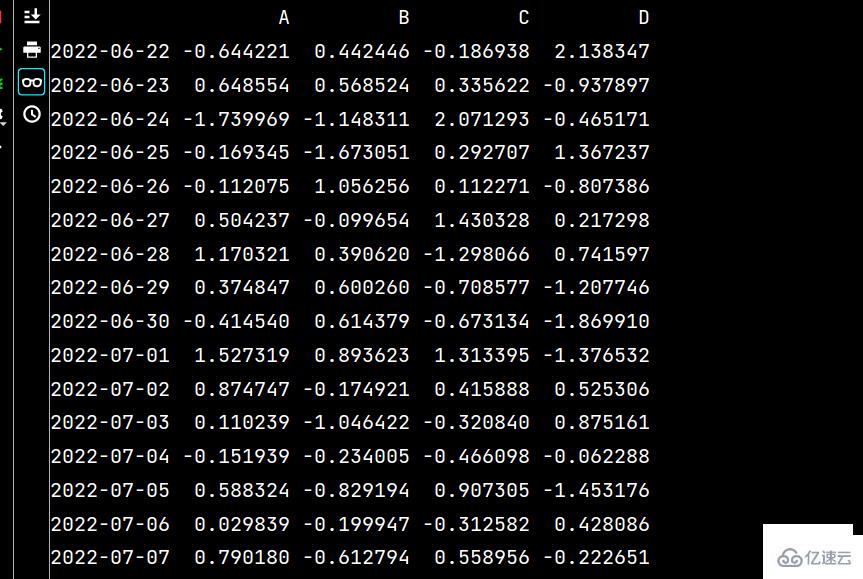
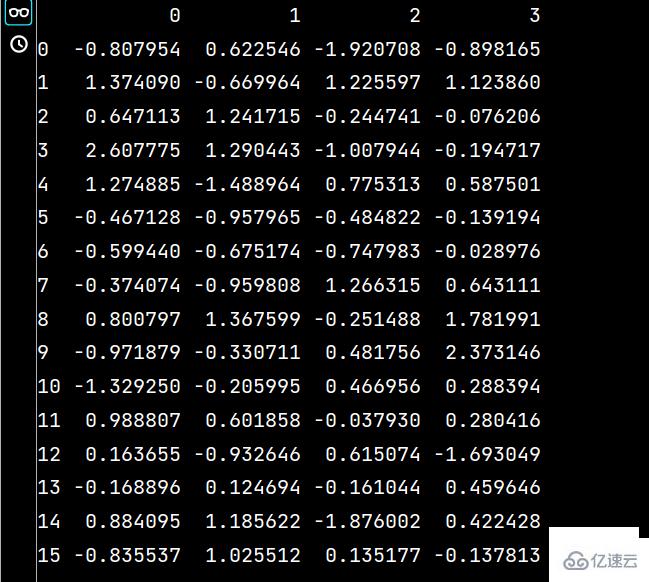
# 將lxw1的數據寫入excel文件
lxw1.to_excel('假期培訓時間.xlsx')
lxw1.to_excel("時間任意.xlsx", index=False) # 不包含行索引
# 將lxw2的數據寫入csv文件
lxw2.to_csv('假期培訓時間.csv')
lxw2.to_csv("時間隨意.csv", index=False) # 不包含行索引
# 創建文件對象
f = pd.ExcelWriter('培訓時間(格式).xlsx')
# 把lxw1寫入Excel文件
lxw1.to_excel(f, "Shell1")
# 把lxw2寫入Excel文件
lxw2.to_excel(f, "Sheet2")
f.save()部分效果圖如下:
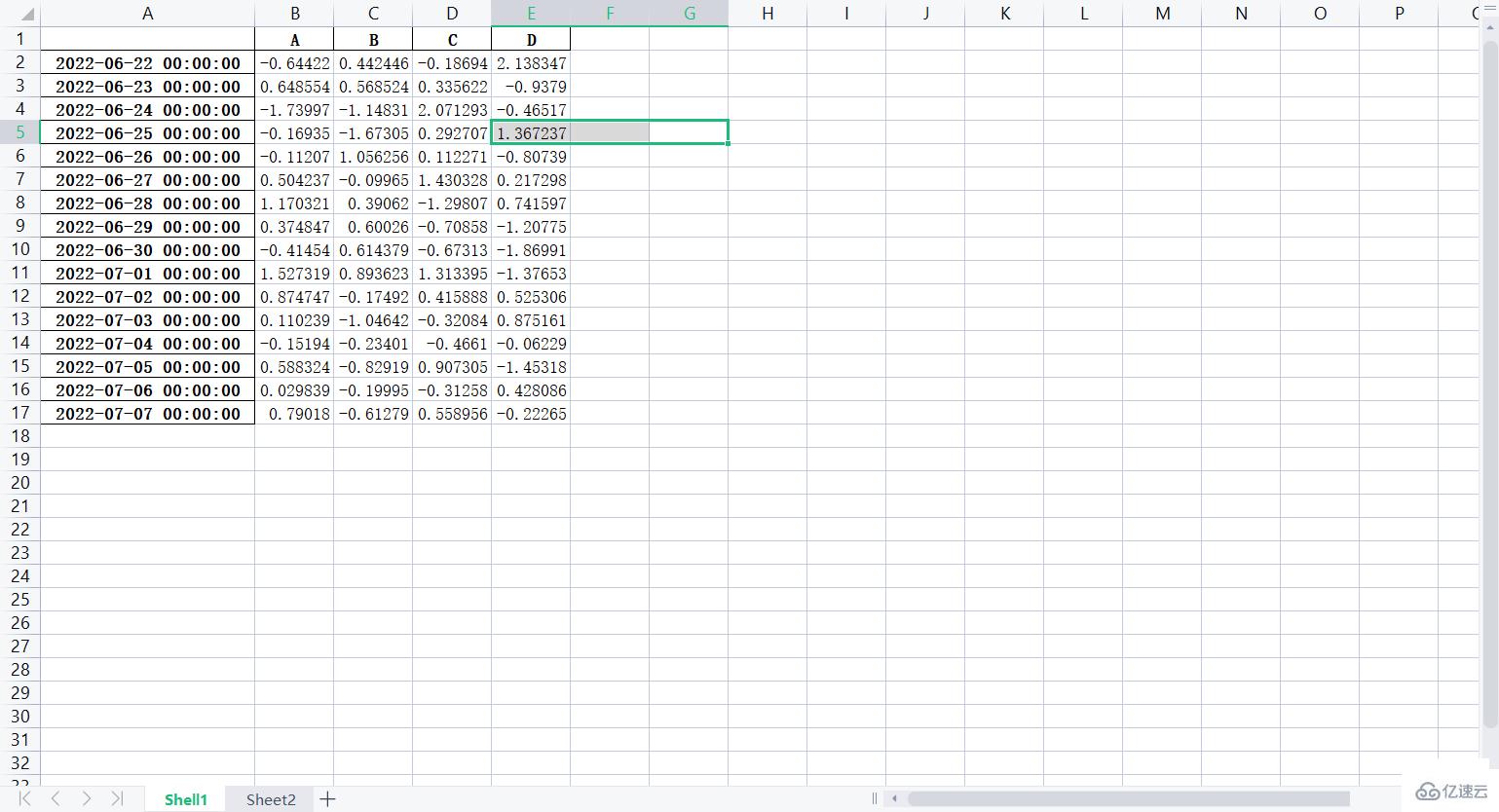
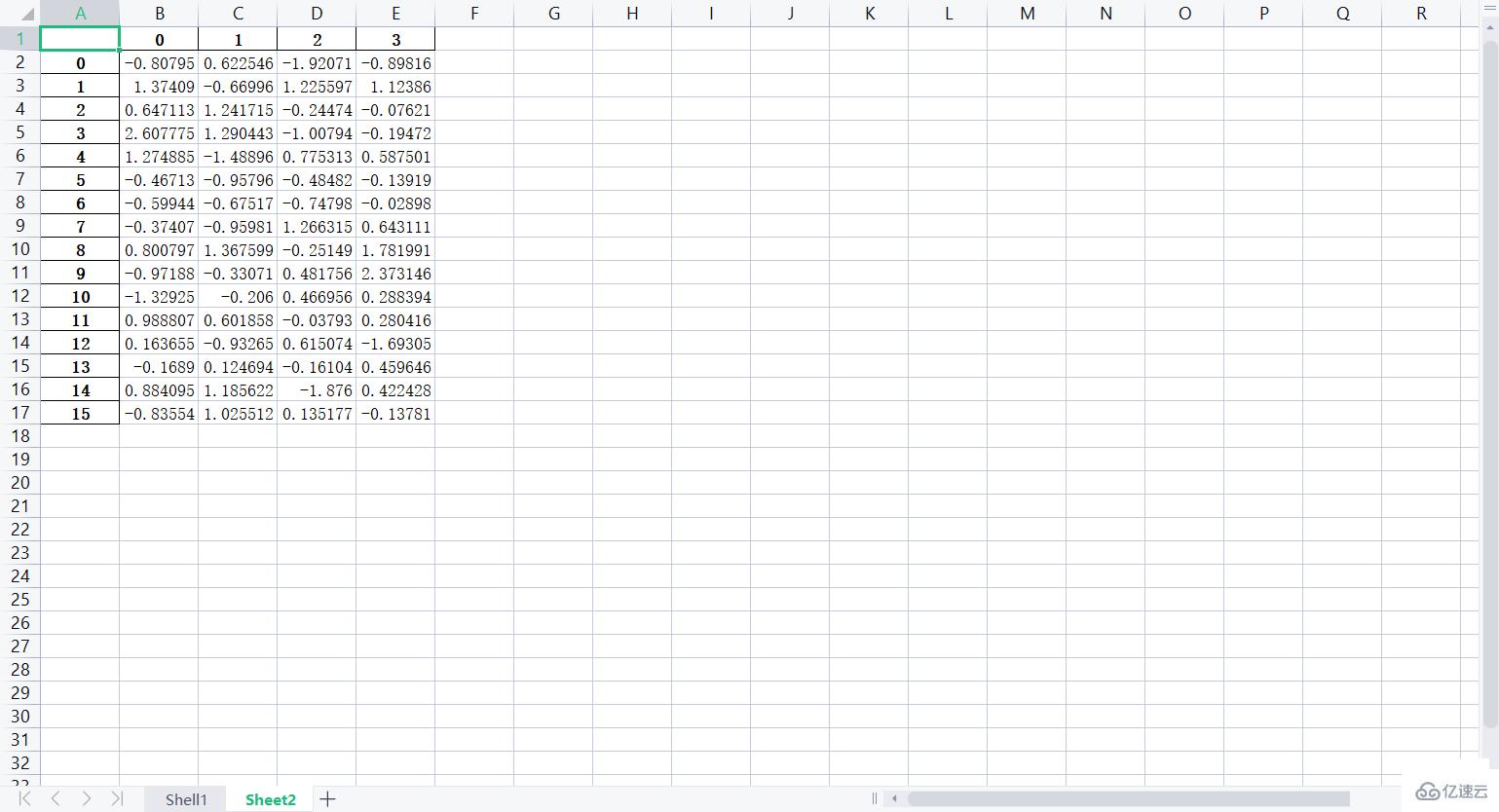
# 從文件中讀入數據:
import pandas as pd
lxw3 = pd.read_csv("假期培訓時間.csv", usecols=range(1, 4))
print(lxw3)運行結果如下:
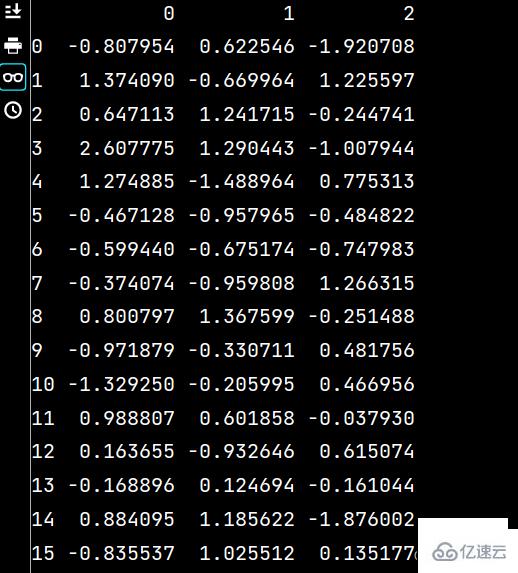
lxw4 = pd.read_excel("培訓時間(格式).xlsx", "Sheet2", usecols=range(1, 3))
print(lxw4)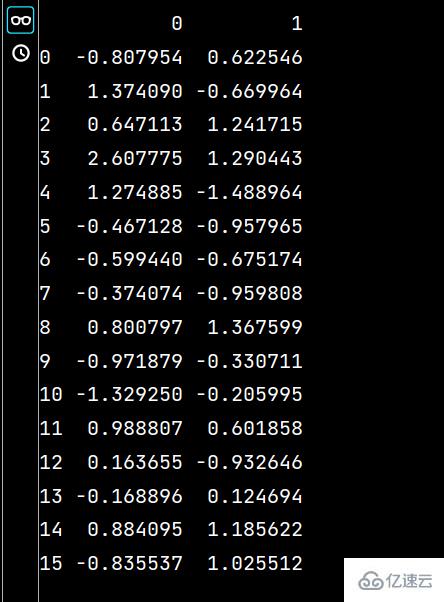
# 數據的一些預處理
# DataFrame數據的拆分、合并和分組計算:
import pandas as pd
import numpy as np
lxw5 = pd.DataFrame(np.random.randint(1, 6, (10, 4)), columns=list('ABCD'))
print(lxw5)
lxww = lxw5[:5] # 獲取前五行數據 print(lxww)
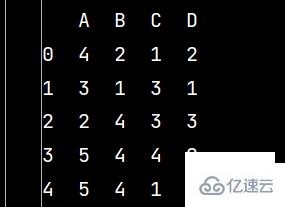
lxwy = lxw5[5:] # 獲取第六行以后的數據 print(lxwy)
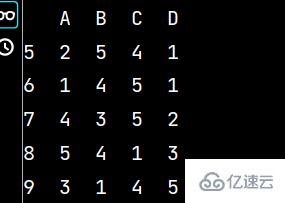
wy = pd.concat([lxww, lxwy]) # 數據行合并 print(wy)
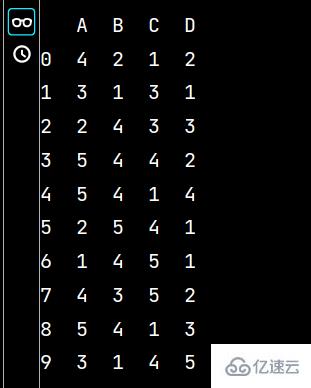
q1 = lxw5.groupby('A').mean() # 數據分組求均值
print(np.around(q1, decimals=2)) # decimals表示保留幾位小數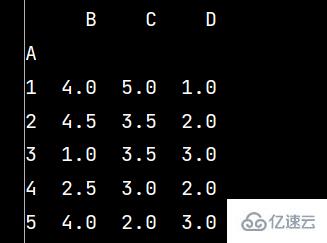
q2 = lxw5.groupby('A').apply(sum) # 數據分組求和
print(q2)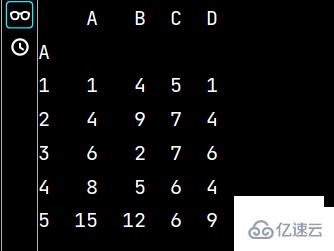
# 數據的選取與操作 ''' 對DataFrame進行選取,要從3個層次考慮:行列、區域、單元格 1-選用中括號[]選取行列 2-使用行和列的名稱進行標簽定位的df.loc[] 3-使用整型索引(絕對位置索引)的df.iloc[] 當然,在數據預處理中,需要對缺失值等進行一些特殊處理 ''' # 數據操作: import pandas as pd import numpy as np qq = pd.DataFrame(np.random.randint(1, 5, (6, 4)), index=['a', 'b', 'c', 'd', 'e', 'f'], columns=['one', 'two', 'three', 'four']) qq.loc['c', 'two'] = np.nan # 修改第三行第二列的數據 print(qq)
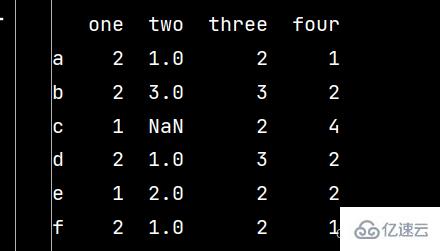
ww = qq.iloc[1:4, 0:2] # 提取第二、三、四行,第一、二列數據 print(ww)
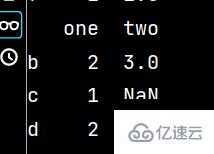
qq['five'] = 'lxw' # 增加第五列數據 print(qq)
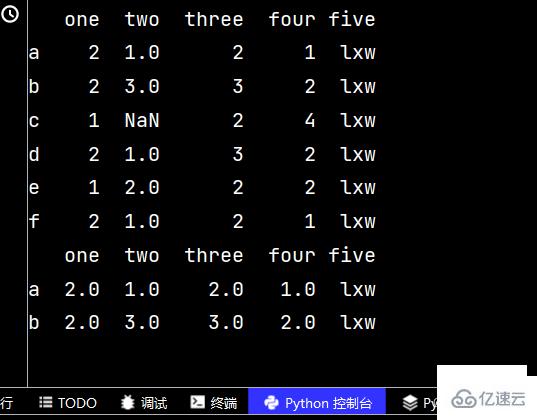
qq2 = qq.reindex(['a', 'b', 'c', 'd', 'e', 'f', 'g']) # 增加行名 print(qq2)
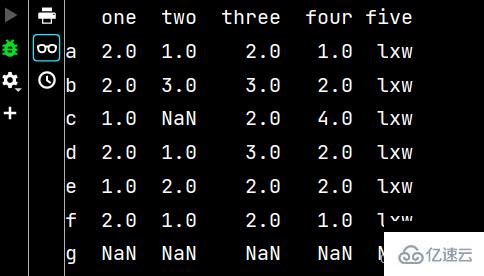
qq3 = qq2.dropna() # 刪除有不確定值的行 print(qq3) # 從輸出不難看出,刪除了c行和g行
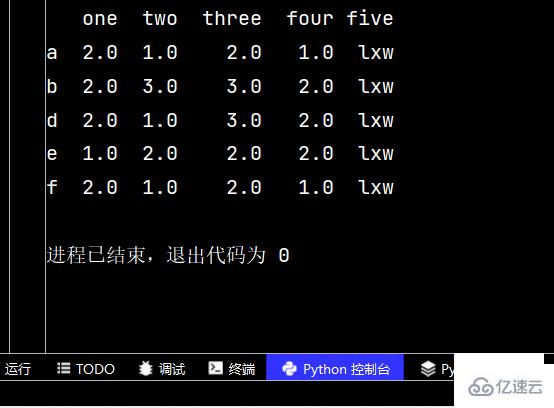
關于“python數學建模之Numpy和Pandas怎么應用”這篇文章的內容就介紹到這里,感謝各位的閱讀!相信大家對“python數學建模之Numpy和Pandas怎么應用”知識都有一定的了解,大家如果還想學習更多知識,歡迎關注億速云行業資訊頻道。
免責聲明:本站發布的內容(圖片、視頻和文字)以原創、轉載和分享為主,文章觀點不代表本網站立場,如果涉及侵權請聯系站長郵箱:is@yisu.com進行舉報,并提供相關證據,一經查實,將立刻刪除涉嫌侵權內容。